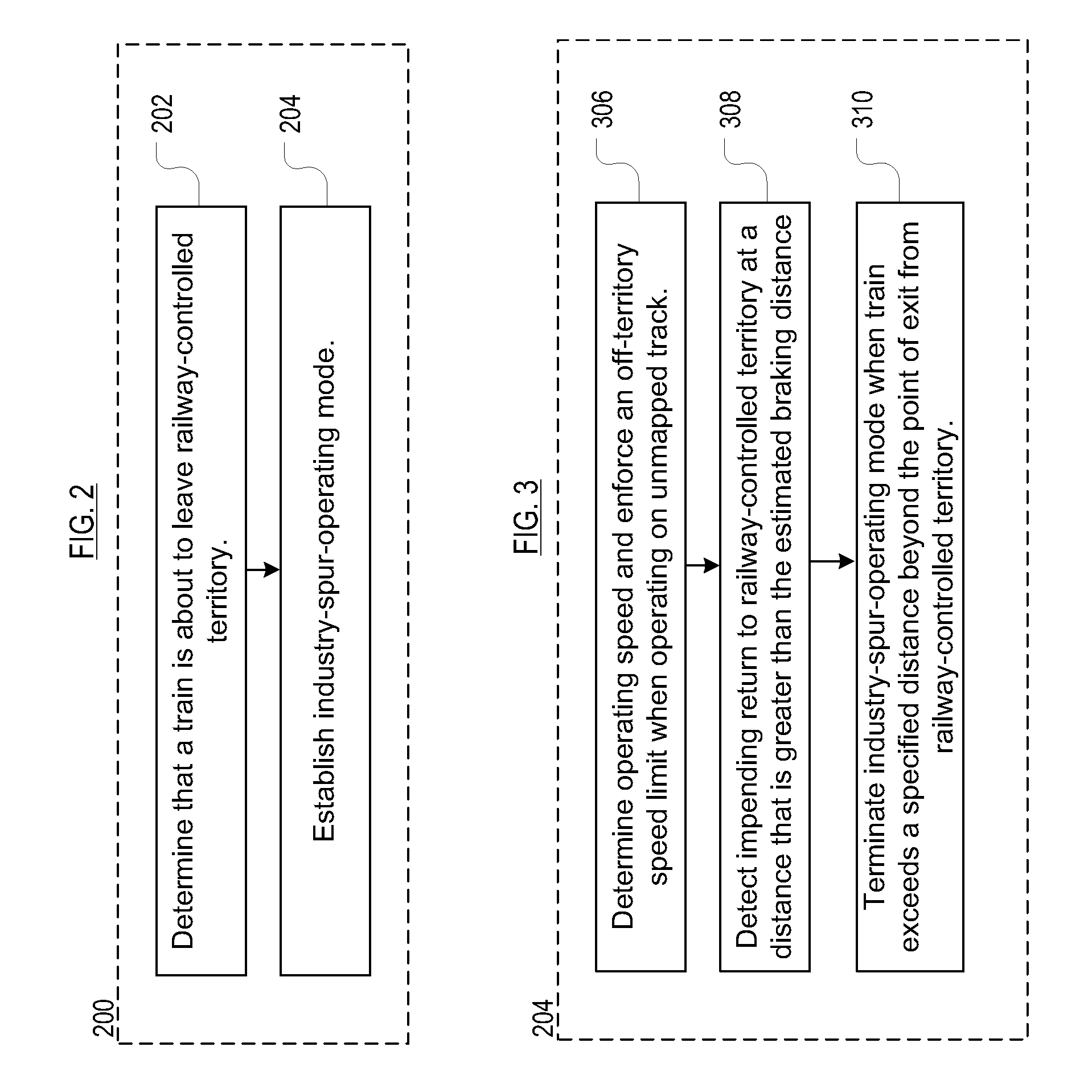Vital Method for Exiting and Re-entering a Mapped Guideway Territory
- Summary
- Abstract
- Description
- Claims
- Application Information
AI Technical Summary
Benefits of technology
Problems solved by technology
Method used
Image
Examples
first embodiment
[0030]FIG. 4 depicts a first embodiment in application of the methods of FIGS. 2 and 3 wherein an OTC-enabled train exits OTC territory through a HT (hand-thrown) switch and operates in an unmapped portion of an industrial spur.
[0031]The operations depicted in FIG. 4 and described below apply as the head-end of a train transitions, at point B, from mapped portion 108 of the spur to unmapped portion 110 (see, FIG. 1).[0032]420: The onboard system remains in the OTC-enabled state and a status of “Industry Spur Operation” (“ISO”) is established.[0033]421: Onboard train control data (e.g., authorities, bulletins, etc.) is maintained and is updateable from the OTC server.[0034]422: The display shows a persistent indication that “ISO” is in effect.[0035]423: A graphic display of mapped track will be frozen to the point when the train exists the mapped track.[0036]424: Internal location reports are formed to indicate a calculated distance extended from the last mapped point on the spur by ...
second embodiment
[0039]FIG. 5 depicts a second embodiment in application of the methods of FIGS. 2 and 3 wherein an OTC-enabled train in ISO operation re-enters OTC territory at point A (FIG. 1) through an HT switch from which the train originally exited.
[0040]The operations depicted in FIG. 5 and described below apply as a train is moving towards the last mapped point B on the spur from which the train exited.[0041]530: The onboard system generates an approach warning for entering OTC territory from an HT spur when it is at a configurable distance (e.g., 0.25 miles).[0042]531: The onboard system evaluates the enforceable limit point on the trailing reverse leg of the HT switch as a Stop & Inspect target using the calculated distance based on ECEF for the purposes of Warning and Enforcement (as if it were on mapped track).[0043]532: If the Stop & Inspect target is properly acknowledged by the crew, the onboard system calculates a route through the switch and evaluates targets on that route. If no au...
third embodiment
[0047]FIG. 6 depicts a third embodiment in application of the methods of FIGS. 2 and 3 wherein an OTC-enabled train in ISO operation re-enters OTC territory at point C through a different HT switch than it originally exited from. This scenario arises in track configurations wherein there are multiple points of entry to the territory in the proximity of the point where the train originally exited mapped track. An alternate point of re-entry to OTC territory will not provide the identical Warnings and Enforcement as if the train re-entered using the spur it originally exited from.
[0048]The operations depicted in FIG. 6 apply as the train moves toward the last mapped point on an entry point other than the spur that they exited from.[0049]640: The onboard control system determines that the train is in proximity of mapped (re-) entry point other than the one on which the train originally entered.[0050]641: The approach warning for entering territory via an HT switch is issued when the tr...
PUM
 Login to View More
Login to View More Abstract
Description
Claims
Application Information
 Login to View More
Login to View More - R&D
- Intellectual Property
- Life Sciences
- Materials
- Tech Scout
- Unparalleled Data Quality
- Higher Quality Content
- 60% Fewer Hallucinations
Browse by: Latest US Patents, China's latest patents, Technical Efficacy Thesaurus, Application Domain, Technology Topic, Popular Technical Reports.
© 2025 PatSnap. All rights reserved.Legal|Privacy policy|Modern Slavery Act Transparency Statement|Sitemap|About US| Contact US: help@patsnap.com



